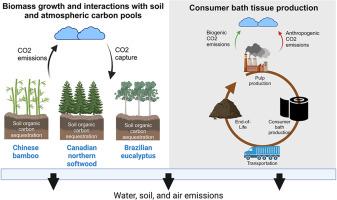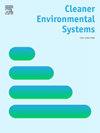含竹和木质卫生组织的生命周期比较评估:纤维来源和转化技术的意义
IF 4.9
Q2 ENGINEERING, ENVIRONMENTAL
引用次数: 0
摘要
本研究评估了在美国使用巴西漂白桉树硫酸盐(BEK)和加拿大北方漂白针叶硫酸盐(NBSK)市场纸浆生产消费者沐浴纸(CBT)对环境的影响,并与中国以竹子为基础的CBT进行了比较。此外,该分析还考虑了植物生长对土壤有机碳(SOC)的固存,以及基于生物量轮作周期的生物源全球变暖潜势(GWPbio)。结果表明,使用轻干蠕变(LDC)技术的美国CBT (70% BEK/ 30% NBSK)从摇篮到坟墓的碳足迹(CF)为1824 kg co2当量/风干吨(ADt)。以BBK代替BEK/NBSK可使CF增加到2041 kg CO2eq/ADt,而中国生产的CBT为2400 kg CO2eq/ADt。使用蠕变槽风干(CTAD), BEK-NBSK和BEK-BBK混合物的CF分别上升到2531和2739 kg CO2eq/ADt。包括SOC因素不会改变结论。而GWPbio因子高度依赖于所考虑的时间范围。这些结果强调了生产技术在组织可持续性中的关键作用,并挑战了竹子的环境优势。本文章由计算机程序翻译,如有差异,请以英文原文为准。

Comparative life cycle assessment of bamboo-containing and wood-based hygiene tissue: Implications of fiber sourcing and conversion technologies
This study assesses the environmental impact of producing consumer bath tissue (CBT) in the United States using Brazilian bleached eucalyptus kraft (BEK) and Canadian northern bleached softwood kraft (NBSK) market pulps, in comparison to bamboo-based CBT from China. Additionally, the analysis includes considerations of soil organic carbon (SOC) sequestration from plant growth, and the biogenic global warming potential (GWPbio) based on biomass rotation periods.
Results indicate a cradle-to-grave carbon footprint (CF) of 1824 kg CO2eq/air-dry ton (ADt) for US CBT (70 % BEK/30 % NBSK) using Light Dry Creped (LDC) technology. Substituting BBK for BEK/NBSK increases CF to 2041 kg CO2eq/ADt, with Chinese manufactured CBT at 2400 kg CO2eq/ADt. Using Creped Trough Air Drying (CTAD), CF rises to 2531 and 2739 kg CO2eq/ADt for BEK-NBSK and BEK-BBK mixtures, respectively. Including SOC factors do not change the conclusions. While the GWPbio factors are highly dependent on the time horizon considered. These results emphasize production technologies' critical role in tissue sustainability and challenge bamboo's perceived environmental advantages.
求助全文
通过发布文献求助,成功后即可免费获取论文全文。
去求助
来源期刊

Cleaner Environmental Systems
Environmental Science-Environmental Science (miscellaneous)
CiteScore
7.80
自引率
0.00%
发文量
32
审稿时长
52 days
 求助内容:
求助内容: 应助结果提醒方式:
应助结果提醒方式:


